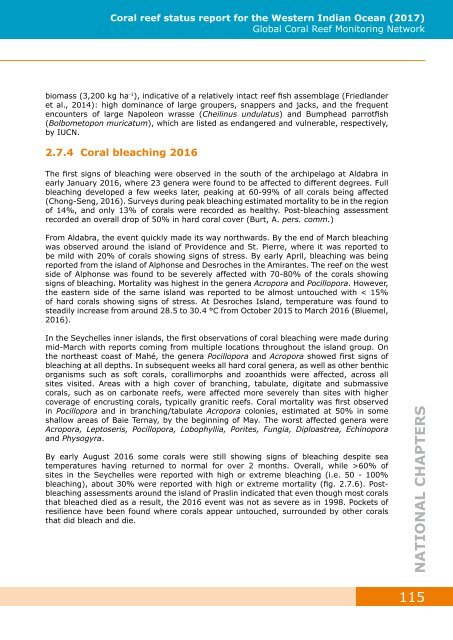GCRMN_COI_2017-Western Indian Ocean Reef Status
GCRMN Western Indian Ocean Coral Reef Status report for 2017. Produced by the Indian Ocean Commission and CORDIO East Africa
GCRMN Western Indian Ocean Coral Reef Status report for 2017. Produced by the Indian Ocean Commission and CORDIO East Africa
You also want an ePaper? Increase the reach of your titles
YUMPU automatically turns print PDFs into web optimized ePapers that Google loves.
Coral reef status report for the <strong>Western</strong> <strong>Indian</strong> <strong>Ocean</strong> (<strong>2017</strong>)<br />
Global Coral <strong>Reef</strong> Monitoring Network<br />
biomass (3,200 kg ha -1 ), indicative of a relatively intact reef fish assemblage (Friedlander<br />
et al., 2014): high dominance of large groupers, snappers and jacks, and the frequent<br />
encounters of large Napoleon wrasse (Cheilinus undulatus) and Bumphead parrotfish<br />
(Bolbometopon muricatum), which are listed as endangered and vulnerable, respectively,<br />
by IUCN.<br />
2.7.4 Coral bleaching 2016<br />
The first signs of bleaching were observed in the south of the archipelago at Aldabra in<br />
early January 2016, where 23 genera were found to be affected to different degrees. Full<br />
bleaching developed a few weeks later, peaking at 60-99% of all corals being affected<br />
(Chong-Seng, 2016). Surveys during peak bleaching estimated mortality to be in the region<br />
of 14%, and only 13% of corals were recorded as healthy. Post-bleaching assessment<br />
recorded an overall drop of 50% in hard coral cover (Burt, A. pers. comm.)<br />
From Aldabra, the event quickly made its way northwards. By the end of March bleaching<br />
was observed around the island of Providence and St. Pierre, where it was reported to<br />
be mild with 20% of corals showing signs of stress. By early April, bleaching was being<br />
reported from the island of Alphonse and Desroches in the Amirantes. The reef on the west<br />
side of Alphonse was found to be severely affected with 70-80% of the corals showing<br />
signs of bleaching. Mortality was highest in the genera Acropora and Pocillopora. However,<br />
the eastern side of the same island was reported to be almost untouched with < 15%<br />
of hard corals showing signs of stress. At Desroches Island, temperature was found to<br />
steadily increase from around 28.5 to 30.4 °C from October 2015 to March 2016 (Bluemel,<br />
2016).<br />
In the Seychelles inner islands, the first observations of coral bleaching were made during<br />
mid-March with reports coming from multiple locations throughout the island group. On<br />
the northeast coast of Mahé, the genera Pocillopora and Acropora showed first signs of<br />
bleaching at all depths. In subsequent weeks all hard coral genera, as well as other benthic<br />
organisms such as soft corals, corallimorphs and zooanthids were affected, across all<br />
sites visited. Areas with a high cover of branching, tabulate, digitate and submassive<br />
corals, such as on carbonate reefs, were affected more severely than sites with higher<br />
coverage of encrusting corals, typically granitic reefs. Coral mortality was first observed<br />
in Pocillopora and in branching/tabulate Acropora colonies, estimated at 50% in some<br />
shallow areas of Baie Ternay, by the beginning of May. The worst affected genera were<br />
Acropora, Leptoseris, Pocillopora, Lobophyllia, Porites, Fungia, Diploastrea, Echinopora<br />
and Physogyra.<br />
By early August 2016 some corals were still showing signs of bleaching despite sea<br />
temperatures having returned to normal for over 2 months. Overall, while >60% of<br />
sites in the Seychelles were reported with high or extreme bleaching (i.e. 50 - 100%<br />
bleaching), about 30% were reported with high or extreme mortality (fig. 2.7.6). Postbleaching<br />
assessments around the island of Praslin indicated that even though most corals<br />
that bleached died as a result, the 2016 event was not as severe as in 1998. Pockets of<br />
resilience have been found where corals appear untouched, surrounded by other corals<br />
that did bleach and die.<br />
NATIONAL CHAPTERS<br />
115


















